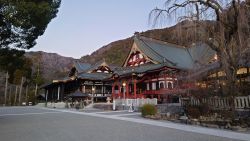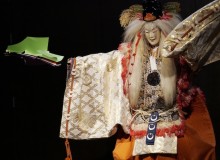
October 24, 2013
Ninjalosophy 101
A new translation reveals the secrets of an ancient ninja manual
By Metropolis
Originally published on metropolis.co.jp on October 2013

Part philosophy, part military strategy, part astrology and part weapons tactics, theBansenshukai is a centuries-old multi-volume treatise of secret ninjutsu knowledge. Writer and ninja historian Antony Cummins and translation partner Yoshie Minami have recently completed the first full English translation of the text. In true ninja fashion, Metropolis sneaks a peek for you.
From Volume I:
“Preface and Prologue”
This writing is hereafter titled the Bansenshukai and from its beginning to the end, it is in accord with important points found in the Kanrinseiyo manual. This Bansenshukai refers to ninjutsu and ninja tools, which have been kept secret by the eleven ninja of Iga and Koka. […] Also, I have collected all the ninjutsu strategies constructed by excellent generals in both Japan and China and I dare to release what has not been made known before.
From Volume V-VII:
“Questions and Answers About Ninjutsu”
The character for shinobi (忍) consists of Blade (刃) and Heart (心). Why was this used for the name of these skills? It is because the entire system of ninjutsu is based on bravery and valour. Therefore, those who have set their mind on this path should single-mindedly try to achieve bravery. To achieve this way you should keep the following in mind: If you do not know the following points, your efforts will be of no use. That is, you should throw away brute courage or blind daring and totally commit to the way through courage of duty. Even though brute courage is in essence, a form of courage, the courage a wise man should keep in mind is the type of courage that arises from a sense of duty.
“Correct Mind”
Brute courage may make you strong or hard out of temporary rage, but it is difficult to keep your mind strong and hard deep at the bottom of your heart as the rage calms down. Even if that strength through force gets to the bottom of your mind and makes you work brave and hard, it is just based on hot-blood and so in most cases it is no more than your blind rage acting and what you are trying to do is bring others to terms by force alone. As a result, you will not have foresight nor be ready to defend yourself fully, and you will only destroy yourself and will not ruin the enemy to any significant level.
“The Art of the Local Agent”
When you intend to infiltrate the enemy castle, you should go to the enemy province before the allied forces have advanced, and research to find someone who is out of employment and ambitious and wishes to acquire fame or bravery, or bears a grudge against or resents your enemy lord, also, commanders and so on, but he cannot express his grievance because of timing, or find someone in the area who has someone from their family within your own allies. Taking the appropriate opportunity, you should approach such a person by using appropriate measures and you should invite them to join your side. Sometimes, you should call on his place to bribe him with gold or nishiki (“expensive brocade”) and make this promise; if he achieves success in his tactics, he will be rewarded with a set amount of stipend and do this with the guarantee of the lord’s red seal. On that basis, you should take hostages from him and make him write an oath, and then place him into the enemy castle with a well considered plan. The enemy lord will have no doubts about him as he is from his own domain, so it will be as easy for him as getting into his own house.

“Points on Secret Signs and Symbols”
On a rainy night, if a watch fire is dead, you may be able to sneak up to the watch fire guard and kill him, or if you come across the enemy togiki (“listening scout”) you may kill or capture him also. There have been many instances of such cases since ancient times. Although you should do this in some situations, it should most definitely be avoided if it is only done when hot-blooded. Only do this if you need to, and if needed to succeed in infiltrating, or if you think you cannot get in there without disposing of them, in such a case you may kill that person. These two points hold true for the case the enemy are not leaving their castle.
When you want to get into an enemy camp, you should go there stealthily on the night before, to record what the crests on their lanterns are like. Then you should go back and create a similar lantern yourself. When you get to the camp discreetly, quickly light the lantern and disguise yourself as a guard, night patrol or fireman or so on, according to the situation and infiltrate with tactics.

When you are sneaking around the enemy castle, even pillars if seen in the moonlight, look like the enemy in silhouette. Not to mistake this, you should be aware that pillars are still and while people move, or that pillars are arrayed orderly and with the same height, while people will not appear to be in straight rows and have they will have differing heights. These pillars are normally for flags or pikes to be rested against.
“HIdden Infiltration Part II”
In an entire castle area, the outer enclosures or the third enclosures are usually surrounded by earthworks and bamboo thickets or it is also the case that the moat is often dry, making it is easy to infiltrate. However, there is little benefit in getting in at that point. If you go firstly to the third enclosure, then the second one and then to the main enclosure, you will have too many difficult obstacles to cross over, therefore it will exhaust you and, if you are not well enough equipped, it will take too much time and trouble, which makes it very likely that you, will be detected. Therefore, you should figure out the best plan using all kinds of ingenuity with the intent to infiltrate the second or main enclosure directly.
“The Skill of the Invisible Mantle”
When you steal in with the secret skills from the kakure-mino no jutsu (“invisible mantle skill”), you should employ yo-kei (“open disguise tactics”) such as katsura-otoko (“undercover agents”), kunoichi (“female agents”) or use the aid of bakemono-jutsu (“the art of copying the enemy clothes”) and so on. If you infiltrate by conducting this art completely, there are no castles or camps that you cannot infiltrate, no matter how impregnable they are.
The Book of Ninja (Watkins Publishing, 2013, 544pp, ¥4,981) is available for pre-order from Amazon Japan and will be in bookstores November 5.
PATH OF THE NINJA

Antony Cummins spoke to Metropolis about the journey leading to the book’s publication
Did any of your beliefs about ninjutsu change during your research for the book?
I have become firmer in my stance that there is no such thing as a special ninja hand-to-hand combat method. The idea of “ninja martial arts” is cemented in my mind as a fabrication of the 20th century. After meeting many Japanese researchers, this stance has been verified by their comments. But on a positive note, the high standard of military skills performed by the real ninja has truly developed in my imagination and has left me wanting to show their true story.
What made you want to tackle the Bansenshukai?
It is the manual. Publishing it is one step in getting the English-speaking world to understand the mind of the ninja, but it is a massive step. We knew it would promote the real history of the ninja and fully open this hidden world for all to see. Now that it’s done, we’re waiting with baited breath for the world to respond to such a colossal amount of information.
How did you find all of the original texts?
The Bansenshukai is very easy to find. An electronic copy has been floating around the internet for years and a facsimile copy can be picked up for $1,000. We based our translation on the copy that is now kept in the National Archives of Japan which was given to the shogunate by real Koka. A few volumes were even published in Japanese, but our book is the first full version in any language. However, the rest of the manuals are buried deep, some in old collections, some in vast storage facilities.
What experts did you consult?
I stand by my statement that there is no such thing as a “ninja expert.” People have started to apply this label to me, something I fully disagree with. Recently Mie University has undertaken research on the collected ninja documents of Iga, so I hope there will be such a thing as a “expert” in the next generation. We are flying blind and learning as we go—a journey into the darkness, so to say.
Is ninjutsu a philosophy or a martial art?
Neither. It is a set of skills that aid two general areas. First there are skills that help support a secret agent on a spying mission, to gain restricted information and to identify if an enemy status is a truth or a falsehood. Secondly, it is a set of skills for special ops and commandos, which allow someone to infiltrate an enemy position and burn it down or to steal information. A ninja followed the samurai philosophy and a did samurai martial arts, but they were a special breed of people who did something quite singular.
What techniques do you find most interesting?
Without doubt it is “sleeping gas,” but I have yet to actually have it tested. You never know if “sleep” means death in medieval lingo.
Do you practice ninjutsu yourself?
No. No one does. If they did, they would be put into prison. Ninjutsu involves espionage, murder, robbery, arson, poisoning, etc. I once asked a man who claimed to practice it if he had burnt any villages down that week. When he said no, I told him that he wasn’t doing ninjutsu. People can study ninjutsu—and it can add a vast benefit to a person’s life—but it cannot be practiced for real.
What’s the biggest myth regarding the ninja?
Most people think that they are separate from the samurai. The ninja were a part of samurai warfare and life. If I can change the readers’ understanding on anything, it would be that the ninja were in fact samurai themselves and that the ninja martial art does not exist.
What do you have in line for your next project?
We will be rebuilding an entire samurai school of war, including their ninja curriculum. Recently, we found the grave and manuals of the samurai Natori Masazumi and contacted the last living members of his family, who gave permission to reopen the school and publish the manual in English.
Do you think there will ever be a realistic ninja movie?
My greatest wish is that one day Hollywood will do a samurai film that shows the reality of the samurai and the ninja. Ninjas jumping through walls ready to die? No thank you.







